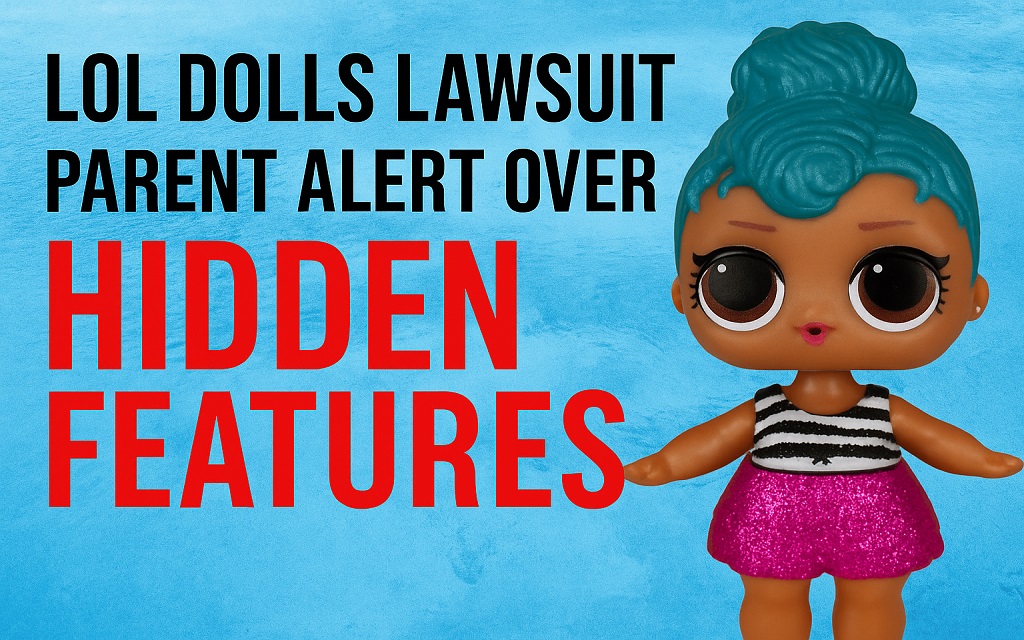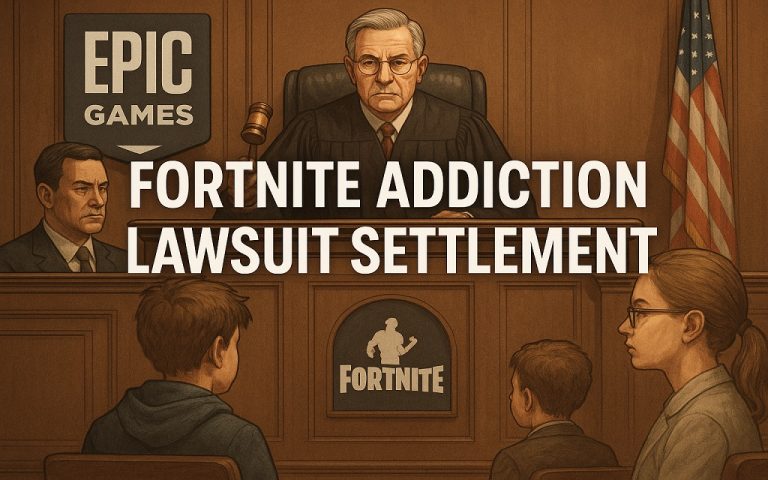The LOL Dolls lawsuit has caught national attention. Parents claim these popular toys hide inappropriate content. The brand is accused of engaging in unethical actions by its critics. The situation has triggered consumer indignation and legal actions. The accusations, the company’s reaction, and the things you should know if you own or have bought these toys are all examined in this article.
What Are LOL Dolls?
LOL Dolls, made by MGA Entertainment. It became a top-selling toy line within a few years. They target young children, primarily girls. The brand offers mystery packaging, collectible dolls, and accessories. Surprise and unboxing features fuel online trends and drive sales.
MGA introduced the first LOL Surprise dolls in 2016. Since then, they’ve grown to LOL OMG, LOL Boys, and LOL Tweens. Each series brings new characters and features.
The Core Allegation
At the heart of the LOL Dolls lawsuit is a disturbing claim. Some parents say the dolls reveal inappropriate outfits when dipped in water. Parents shared images online showing lingerie-like clothing under regular doll appearances.
Outrage followed. Critics argued the brand failed to warn consumers. Parents felt betrayed. Legal experts labeled this a potential failure in disclosure and product labeling.
Why Have Parents Filed Complaints About LOL Dolls?
You may wonder what sparked the backlash. Parents across the U.S. shared videos online showing LOL Surprise Dolls in cold water. The dolls revealed outfits that resembled lingerie or provocative wear. Consumers raised questions about age-appropriateness.
It is essential to know that MGA Entertainment did not list these changes on the packaging. Many parents argued that the company misled them by hiding the water-reveal feature. You may have seen hashtags like #BoycottLOL and #LOLDolls trending on TikTok and YouTube.
In 2021, viral videos pushed the controversy into the legal domain. Law firms took an interest. Consumer groups called for corporate transparency. According to Safe Kids Worldwide, nearly 1 in 4 parents now review toy features online before making a purchase.
What Legal Grounds Do the Lawsuits Rely On?
You should be aware that the legal arguments primarily focus on deceptive marketing practices. Attorneys claim MGA Entertainment violated state and federal consumer protection laws. The primary complaints include:
- Misrepresentation of product features
- Emotional distress caused to children
- Violation of truth-in-advertising standards
- Failure to disclose age-sensitive content
You may also find references to Federal Trade Commission (FTC) guidelines. The FTC expects clear labeling for all child-targeted products. Legal filings suggest the company failed to provide full disclosure.
Courts may consider violations under the Consumer Product Safety Act. Under Section 6, failure to report material risks could trigger civil penalties. A class-action framework may apply if multiple plaintiffs share the exact cause of injury.
How the Water-Reveal Feature Works
This controversy centers on the “water-reveal” feature. MGA markets this as a fun surprise. However, users discovered that submerging certain dolls in cold water triggered unexpected changes. Some outfits appeared too mature for the toy’s target age group.
Many parents recorded these transformations. The footage circulated on social media. Hashtags like #LOLDolls and #BoycottLOL trended. Public reaction forced MGA to respond.
How Can You Identify Dolls With the Water-Reveal Feature?
Parents often ask how to detect the problematic feature. You should inspect the packaging for icons related to temperature play. MGA uses water-drop symbols to show transformation features.
Here are steps you can take:
- Place the doll in cold water
- Observe clothing or hair color changes
- Photograph results for records
- Contact customer support if needed
You may also look at collector forums. Many communities list models known to reveal adult-themed outfits. Brands like LOL and OMG, as well as LOL Tweens, often appear in those lists.
How Did MGA Entertainment Respond to These Allegations
MGA released statements defending their product design. They denied intent to include suggestive content. They emphasized that the water-reveal feature was part of a long-standing product gimmick. The company claimed the water-reveal feature had always existed. You should be aware that MGA has released a public statement explaining that the dolls have passed internal safety tests.
MGA blamed social media for fueling misinformation. They claimed the dolls passed safety and ethics testing. Still, many parents remained unconvinced. Consumer forums questioned why such transformations were not shown in product ads or boxes. Some retailers even temporarily pulled LOL Dolls from their shelves.
The company promised an internal review. They also issued guidance on how to identify dolls that feature this design. You may ask why the company did not revise the packaging. It is essential to understand that reprints, supply chains, and legal risks make sudden changes difficult. Still, the company offered no apology.
Must Read: Purple Mattress Lawsuit: What Really Happened and Why It Matters
Legal Action and Consumer Protection
Several law firms began reviewing complaints. The LOL Dolls lawsuit now includes claims of product misrepresentation. Parents allege emotional distress and consumer deception.
Legal filings reference FTC guidelines on advertising to children. Critics argue MGA violated those guidelines. They say the dolls’ design exploits child psychology and parent trust.
Lawyers also focus on the failure to disclose clearly on the packaging. Some argue this violates truth-in-advertising laws.
Potential Lawsuit Outcomes
The LOL Dolls lawsuit could bring financial penalties, forced product recalls, or packaging changes. If courts rule against MGA, it may set a precedent for other toy companies.
Class-action lawsuits could emerge. Thousands of families qualify for legal standing. The case may also influence future regulations in the toy industry.
Parental Concerns and Social Media Backlash
Parents have voiced concerns across various platforms, including Facebook, TikTok, and YouTube. Viral videos exposed water-reveal changes. Hashtags demanded accountability. Influencers joined the discussion.
You might not expect dolls to spark moral debates. But many parents feel that toys influence values and behavior. Pediatric psychologists share this view. According to the American Academy of Pediatrics, the content of toys impacts early emotional development.
Social trust also plays a role. You expect toys to align with family standards. When a doll reveals mature themes without warning, it feels like a breach of trust. Surveys from Pew Research show that 63% of parents now seek ethics over novelty when buying toys.
Some former customers destroyed or returned dolls. Many said they would avoid the brand entirely. The brand’s reputation took a hit. Public relations experts say MGA mishandled the initial response. Critics wanted transparency, not denial.
What Do Regulatory Bodies Say About the Issue?
Consumer watchdogs now monitor the case. The U.S. Consumer Product Safety Commission (CPSC) has not yet taken formal action. But the case raises questions about regulatory gaps in toy marketing.
You should also know that the Children’s Advertising Review Unit (CARU) has addressed similar issues in other toy lines. CARU promotes responsible advertising to children. Legal experts believe that MGA may receive pressure from multiple industry bodies.
It is worth noting that the FTC can issue fines for deceptive labeling under Section 5 of the FTC Act. The LOL Dolls lawsuit may push the agency to clarify rules for surprise-based toys.
Child advocacy groups push for stricter rules. They want more transparent labeling, mandatory disclosures, and ethical design audits.
The FTC may also investigate whether deceptive marketing practices were employed. If they do, MGA could face fines or sanctions.
Ethical Questions in Toy Design
The LOL Dolls case reveals larger problems. How much surprise is too much in children’s toys? Where do manufacturers draw the line between fun and inappropriate?
Critics argue that the toy industry needs to establish ethical boundaries. Toys should reflect age-appropriate standards. Surprise elements should never cross into adult-themed imagery.
Child psychologists have entered the debate. They warn that inappropriate content—intentional or not—can harm child development. Kids mimic what they see. They trust their toys.
Who Qualifies for Legal Compensation?
You may be eligible for legal action if you purchased LOL Dolls within the past three years. Affected families may join a class-action lawsuit. Legal advisors often ask for:
- Proof of purchase
- Photo or video evidence
- Emotional or psychological impact on the child
- Any communication with MGA
Attorneys review claims under state-level Unfair and Deceptive Acts and Practices (UDAP) laws. Many parents from California, Texas, and New York have filed early claims.
Class actions may seek compensation for emotional damage, refunds, and policy changes. You should consult a consumer law expert to understand your options.
What Parents Should Do Now?
If you own LOL Dolls, inspect them. Check the packaging for water-reveal icons. Test the dolls in cold water if needed. Document anything inappropriate.
Consider contacting a consumer rights attorney. Many offer free consultations. You may qualify for legal relief.
Report issues to the CPSC. This helps build a stronger case and supports broader investigations.
Talk to your children. Explain why certain toys may no longer be safe. Open conversations help build trust and emotional safety.
What Do Child Development Experts Say?
You may wonder how a toy can cause distress. Experts like Dr. Deborah Gilboa, a pediatric behavior specialist, explain that children form early body image ideas from toys. Dolls with hidden adult features may confuse or alarm them.
According to Child Mind Institute, toys that suggest provocative themes create identity conflicts in children under eight. You should be aware that visual cues significantly influence childhood norms.
If your child reacted strongly to a doll’s water reveal, therapists recommend open discussion. Reassure your child. Ask questions about what they saw and how it made them feel.
What Precedents Exist in Toy Industry Lawsuits
You may ask how the LOL Dolls lawsuit compares with others. Toy brands like Bratz, also owned by MGA, faced backlash for overly mature themes in the early 2000s.
In 2014, Hasbro faced criticism for its “Oven-Bake” doll that allegedly led to finger injuries. That led to a partial recall and design change.
Courts often consider marketing intent, consumer impact, and the level of disclosure. You should be aware that precedents play a crucial role in establishing future legal boundaries for toy manufacturers.
What Can You Do to Protect Your Child
It is your right to ensure the safety of toys. You can follow these steps:
- Check independent reviews before buying
- Read product disclosures thoroughly
- Avoid toys with vague or mystery features
- File complaints with the CPSC or FTC
- Educate your child about appropriate content
You may also contact legal aid centers if you suspect that harm has occurred. Many firms offer free evaluations for potential claims.
What Makes the LOL Dolls Lawsuit Unique
This is not a recall due to choking hazards or sharp parts. The LOL Dolls lawsuit centers on values, trust, and parental authority. MGA faces moral questions, not just legal ones.
The case mixes product marketing, childhood psychology, and legal rights. It challenges how far brands can go in hiding features under the veil of “surprise.”
Related Lawsuits in the Toy Industry
LOL Dolls are not alone. Other brands faced lawsuits for misleading features. Some cases involved gender stereotypes, others unsafe materials.
These past cases show courts favor transparency. Judges expect clear warnings. Hidden features raise red flags.
The LOL Dolls lawsuit fits that pattern. Legal experts say it could drive systemic change.
Media Coverage and Brand Damage
News outlets picked up the story. Articles on CNN, Today, and The New York Post covered the backlash. Consumer blogs and watchdog sites echoed concerns.
Stockholders reacted. MGA is a private company, but sales metrics show declines after the controversy.
Retailers received complaints. Some even temporarily pulled the dolls from the shelves. Public trust plays a central role in toy sales.
What Long-Term Changes Might This Lawsuit Bring?
You may expect changes in how toy companies market surprise products. The lawsuit could force manufacturers to:
- Label toys with more explicit warnings
- Disclose all transformation features
- Submit products to stricter review boards
- Re-evaluate age-group marketing strategies
Retailers may also require complete transparency before stocking toys. The case may influence global product labeling standards.
If parents win this case, it could lead to a shift in the toy industry toward full disclosure and more ethical design frameworks.
Conclusion
In short, the LOL Dolls lawsuit underscores the importance of transparent and honest design in children’s products. Parents expect transparency. Brands must earn trust.
If you feel misled or upset by a toy your child owns, legal help is available. Consumer laws exist to protect families. The LOL Dolls controversy could shift how toys are marketed, labeled, and trusted going forward.
FAQs
What is the LOL Dolls lawsuit about?
You should know the lawsuit focuses on dolls that reveal adult-themed outfits when exposed to cold water. Parents claim this was not disclosed on the packaging.
How do you identify LOL Dolls with hidden features?
You can check the packaging for water symbols, place dolls in cold water, and document any unexpected visual changes for evidence.
Can you join a class action if you bought LOL Dolls?
You may qualify if you purchased the dolls in the past three years and can show proof of harm or misleading packaging.
What laws does MGA Entertainment allegedly violate?
You should be aware that attorneys frequently cite consumer protection laws and FTC regulations regarding clear advertising and truthful labeling.
Disclaimer:This article provides a general overview of the L.O.L. dolls lawsuit based on publicly available information and official sources.




